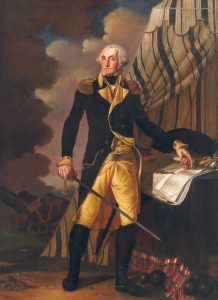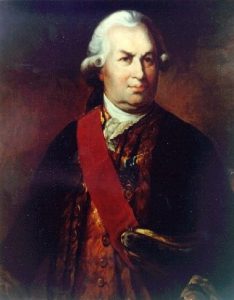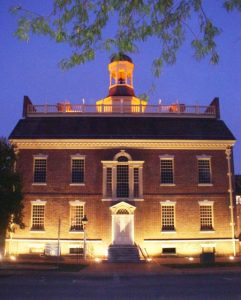Battle of the Chesapeake program at Dover, Del.’s Old State House on Oct. 12, 2019
Historical and Cultural Affairs | Kent County | Newsroom | Date Posted: Friday, October 4, 2019
Historical and Cultural Affairs | Kent County | Newsroom | Date Posted: Friday, October 4, 2019

(DOVER, Del.—Oct. 4, 2019)—On Saturday, Oct. 12, 2019 at 1:30 p.m., The Old State House, located at 25 The Green in Dover, Del., will offer a multi-media presentation by historic-site interpreter Tom Welch on the Battle of the Chesapeake, a decisive naval engagement of the American Revolutionary War in which a French fleet under Adm. de Grasse paved the way for the surrender of British Gen. Cornwallis at Yorktown and the ultimate American victory in its struggle for independence from Great Britain. The program is being presented in commemoration of the 238th anniversary of both the battle and Cornwallis’ surrender. Admission to the program is free and open to the public. For additional information, call 302-744-5054.

About the Battle of the Chesapeake …
On Sept. 5, 1781 the French fleet, under the command of Adm. François Joseph Paul de Grasse, and the British fleet, under Adm. Thomas Graves, fought ferociously for control of the entrance to the Chesapeake Bay. The engagement, known as the Battle of the Chesapeake, or the Battle of the Capes, was exceedingly important to the success of the American cause as it denied the British fleet the opportunity to come to the aid of Gen. Charles Cornwallis who was besieged at Yorktown, Va. by a combined Franco-American force under the overall command of Gen. George Washington.

The battle was the culmination of months of planning and communication that had gone on between the leaders of the American and French forces. Washington and Gen. Jean-Baptiste Donatien de Vimeur de Rochambeau had been planning the final attack on the British, either in New York or in Virginia. They had communicated with de Grasse that they needed his support to gain naval superiority. De Grasse sent the message that they should meet in the Chesapeake region, so the American and French troops made the 550-mile march from Newport, R.I. to Williamsburg, Va., and then to Yorktown, where a decisive victory took place on Oct. 19, 1791 with Cornwallis’ surrender.

The Battle of the Chesapeake has been characterized by many historians as the key to Cornwallis’ surrender and, ultimately, to the American victory in the Revolutionary War. Neither side won a decisive victory in the battle itself—but since the goal of the Franco-American alliance was to keep Cornwallis bottled up, it should be considered a strategic victory for de Grasse and his French fleet, and therefore for the American cause.

Completed in 1791, The Old State House is one of the earliest capitol buildings in the United States, serving as the home of Delaware’s legislature until 1933 when the General Assembly moved to larger quarters in Legislative Hall. The venerable structure now appears as it would have in the late 1700s during the United States’ critical early years as a nation. It features a courtroom, governor’s and county offices and chambers for the state’s Senate and House of Representatives. The building is situated on Dover’s historic Green, a public area designated by William Penn in 1683. The Green is a partner site of the First State National Historical Park.

The Old State House is administered by the Division of Historical and Cultural Affairs, an agency of the State of Delaware. The division enhances Delaware’s quality of life by preserving the state’s unique historical heritage, fostering community stability and economic vitality and providing educational programs and assistance to the general public on Delaware history. The division’s diverse array of services includes operation of five museums which are accredited by the American Alliance of Museums, administration of the State Historic Preservation Office, conservation of the state’s archaeological and historic-objects collections, operation of a conference center and management of historic properties across the state. Primary funding for division programs and services is provided by annual appropriations from the Delaware General Assembly and grants from the National Park Service, Department of the Interior, a federal agency. However, the contents and opinions expressed in the division’s programs and services do not necessarily reflect the views and policies of the Department of the Interior.
-End-
Contact:
Jim Yurasek
Delaware Division of Historical and Cultural Affairs
Phone: 302-739-7787
E-mail: Jim.Yurasek@delaware.gov
Web: http://history.delaware.gov
Keep up to date by receiving a daily digest email, around noon, of current news release posts from state agencies on news.delaware.gov.
Here you can subscribe to future news updates.
Historical and Cultural Affairs | Kent County | Newsroom | Date Posted: Friday, October 4, 2019

(DOVER, Del.—Oct. 4, 2019)—On Saturday, Oct. 12, 2019 at 1:30 p.m., The Old State House, located at 25 The Green in Dover, Del., will offer a multi-media presentation by historic-site interpreter Tom Welch on the Battle of the Chesapeake, a decisive naval engagement of the American Revolutionary War in which a French fleet under Adm. de Grasse paved the way for the surrender of British Gen. Cornwallis at Yorktown and the ultimate American victory in its struggle for independence from Great Britain. The program is being presented in commemoration of the 238th anniversary of both the battle and Cornwallis’ surrender. Admission to the program is free and open to the public. For additional information, call 302-744-5054.

About the Battle of the Chesapeake …
On Sept. 5, 1781 the French fleet, under the command of Adm. François Joseph Paul de Grasse, and the British fleet, under Adm. Thomas Graves, fought ferociously for control of the entrance to the Chesapeake Bay. The engagement, known as the Battle of the Chesapeake, or the Battle of the Capes, was exceedingly important to the success of the American cause as it denied the British fleet the opportunity to come to the aid of Gen. Charles Cornwallis who was besieged at Yorktown, Va. by a combined Franco-American force under the overall command of Gen. George Washington.

The battle was the culmination of months of planning and communication that had gone on between the leaders of the American and French forces. Washington and Gen. Jean-Baptiste Donatien de Vimeur de Rochambeau had been planning the final attack on the British, either in New York or in Virginia. They had communicated with de Grasse that they needed his support to gain naval superiority. De Grasse sent the message that they should meet in the Chesapeake region, so the American and French troops made the 550-mile march from Newport, R.I. to Williamsburg, Va., and then to Yorktown, where a decisive victory took place on Oct. 19, 1791 with Cornwallis’ surrender.

The Battle of the Chesapeake has been characterized by many historians as the key to Cornwallis’ surrender and, ultimately, to the American victory in the Revolutionary War. Neither side won a decisive victory in the battle itself—but since the goal of the Franco-American alliance was to keep Cornwallis bottled up, it should be considered a strategic victory for de Grasse and his French fleet, and therefore for the American cause.

Completed in 1791, The Old State House is one of the earliest capitol buildings in the United States, serving as the home of Delaware’s legislature until 1933 when the General Assembly moved to larger quarters in Legislative Hall. The venerable structure now appears as it would have in the late 1700s during the United States’ critical early years as a nation. It features a courtroom, governor’s and county offices and chambers for the state’s Senate and House of Representatives. The building is situated on Dover’s historic Green, a public area designated by William Penn in 1683. The Green is a partner site of the First State National Historical Park.

The Old State House is administered by the Division of Historical and Cultural Affairs, an agency of the State of Delaware. The division enhances Delaware’s quality of life by preserving the state’s unique historical heritage, fostering community stability and economic vitality and providing educational programs and assistance to the general public on Delaware history. The division’s diverse array of services includes operation of five museums which are accredited by the American Alliance of Museums, administration of the State Historic Preservation Office, conservation of the state’s archaeological and historic-objects collections, operation of a conference center and management of historic properties across the state. Primary funding for division programs and services is provided by annual appropriations from the Delaware General Assembly and grants from the National Park Service, Department of the Interior, a federal agency. However, the contents and opinions expressed in the division’s programs and services do not necessarily reflect the views and policies of the Department of the Interior.
-End-
Contact:
Jim Yurasek
Delaware Division of Historical and Cultural Affairs
Phone: 302-739-7787
E-mail: Jim.Yurasek@delaware.gov
Web: http://history.delaware.gov
Keep up to date by receiving a daily digest email, around noon, of current news release posts from state agencies on news.delaware.gov.
Here you can subscribe to future news updates.